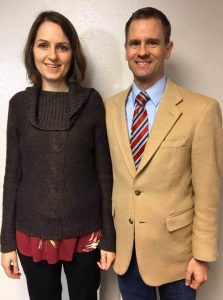Decision to Stop Dosing in Tominersen Trial ‘Pretty Hard to Take’
Written by |

Sarah Lynn Mays learned she wouldn’t be returning to Northwestern University for her scheduled intrathecal injection of tominersen when her younger sister called to give the news — Roche was stopping dosing for its Phase 3 clinical trial of the Huntington’s disease treatment.
It felt “almost like losing someone twice,” said Mays, 40, in a phone interview with Huntington’s Disease News from her Chicago home. The first loss has been her gradual decline since diagnosed with the neurological disorder three years ago. The second came March 22, when she learned she could not continue on a treatment she felt was making a difference.
She enrolled in the Phase 3 trial (NCT03761849) of tominersen in spring 2019 before moving to its open-label extension (OLE) (NCT03842969) in February 2020, where she was likely to be treated every four months through mid-2024. Because the main trial’s assigned dosing group — treatment every eight or 16 weeks, or placebo — remains blinded to participants, Mays cannot say for sure whether she was given tominersen while in that study, called GENERATION HD1. But she noticed some easing of her symptoms throughout 2019, which continued through the OLE (called GEN-EXTEND), and suspects she was being treated.
Mays suffers with chronic fatigue from Huntington’s, which forced her to quit teaching anatomy and physiology labs one day a week at Depaul University, and to skip church on Sundays. But treatment with tominersen, Mays says, restored the energy needed to make it to her place of worship and the mental ability to follow conversations, another Huntington’s disease-related struggle.
Roche emphasizes that, while treatment dosing has stopped for all, patients are asked to continue with examinations that monitor tominersen’s safety and possible efficacy.
Dosing stopped due to a lack of effectiveness seen in a pre-planned interim analysis of trial data by the study’s independent monitoring board.
It specifically looked at data covering patients in the GENERATION HD1 study for 69 weeks (about a year and a half). Findings covered about 60% of participants in each of the three study groups.
Favorable outcomes not evident
Data from the Phase 1/2a study (NCT02519036) was promising, supporting the larger trial. Findings from that early study showed a reduction in mutant huntingtin protein — which tominersen was designed to target in the brain — levels by up to 60%.
The company presented data from the Phase 3 trial that prompted the stop order at a recent webinar hosted by the Huntington’s Disease Society of America.
“We do not see any benefit or favorable outcome for tominersen treatment versus placebo,” said Lauren Boak, PhD, global development team leader, product development neuroscience at Roche.
Data analyses by the monitoring committee found scores on the Composite Unified Huntington’s Disease Rating Scale (cUHDRS) — which measures cognition as well as motor abilities and functional capacity — for patients on a placebo comparable to those given tominersen once every 16 weeks. More troubling, cUHDRS scores for patients treated most frequently — once every eight weeks — worsened more quickly over the trial’s 69 weeks than they did for the placebo group.
“Everybody was kind of putting their hopes into this, that this was going to be the one that worked,” said Dave Stickles, vice president of the Huntington’s Disease Society of America’s Michigan chapter. His friend with Huntington’s died from aspiration pneumonia 19 years ago, and that man’s twin sons are now in the early stages of the disease.
“It was pretty hard for everybody to take,” Stickles said.
Vicki Wheelock, a neurologist and director of the HDSA Center of Excellence at the University of California Davis, a site for the Phase 3 study, addressed in Roche’s presentation anecdotal evidence given by patients pointing toward improvement with tominersen. She thought this unsurprising, but not proof of efficacy, and noted that further analysis of trial findings are needed.
“There are people who have probably felt they are doing better. There’s some benefits from being in the study, perhaps related to receiving the ASO [antisense oligonucleotide, such as tominersen],” she said. And there’s probably “some people who have noticed no change at all, and we probably have some who felt they weren’t getting better.”
Wave Life Sciences, just weeks after the Roche decision, also stopped its Phase 1b/2a clinical trials of two potential Huntington’s treatments — WVE-120101 (NCT03225833) and WVE-120102 (NCT03225846) — based on trial data that was deemed not statistically significant.
No safety issues were found in either the Roche or Wave trials.
Trial problems, in patient’s view
Before being diagnosed with Huntington’s disease, Mays got her PhD in neuroscience from the University of Illinois Chicago and studied neurodegenerative diseases, including the one with which she later would be diagnosed.
Mays created a public Facebook group, Understanding Tominersen RG6042 Huntingtons Disease, days after the dosing stop was announced. Its stated goal is to “gather information from participants in the Tominersen clinical trial.”
While Mays acknowledges she’s no expert in clinical trial design, she felt some things could have been done differently.
“When a drug with so much promise cannot make it through this process that is a strong indicator that there could be some serious concerns with the process in place for the approval of these drugs,” Mays said.
She estimated 80% of the trial’s assessment questions focused on chorea, the most common involuntary movement problem in Huntington’s. But she felt this symptom ranked lower compared with chronic fatigue, and said some members of her Facebook page put hunger higher on the list.
“I have noticed a big improvement in many aspects of my life [with tominersen] that may not have been captured by the questions used in the trial,” Mays said.
She sent Roche a three-page letter with feedback for the trial. Mays said the cUHDRS questions were “generic and vague,” and did not clearly track her progress. In the document, Mays also wrote that picking a number on a one to five scale to assess behavior was “limiting.” A one to 10 scale, she suggested, “would capture these improvements far better.”
These outreach efforts led to a call from Roche, she said, and a representative said the company is receptive to her feedback.
Looking to the future
George Yohrling, the Huntington’s Disease Society’s chief scientific officer and chief mission officer, felt the news was like a “sucker punch.” Still, he is confident that targeting the mutant huntingtin protein is a good approach, either via gene therapy or treatments like RNA splicing modulators.
Mays agreed. “I think shutting down the gene at the source is the best way to go,” she said.
uniQure is in the midst of a Phase 1/2 gene therapy study (NCT04120493) that will deliver AMT-130, a microRNA therapy, directly to a brain region responsible for movement control.
PTC Therapeutics is developing a pre-messenger RNA splicing modulator, PTC518, which introduces a “stop” signal in messenger RNA to help degrade the mutant huntingtin protein, lowering its production.
Novartis developed a similar oral treatment for spinal muscular atrophy, branaplam, that was found to also lower mutant huntingtin protein levels. The company plans to start its Phase 2b trial in Huntington’s this year, according to a press release.
Wave, in announcing the stop of its trials, touched on plans to open a Phase 1/2 trial this year of a next-generation potential treatment also targeting the mutant protein, which it calls WVE-003.
“While we were all very disappointed, I’d say that our optimism, or enthusiasm, for the approach of targeting the mutant huntingtin gene is not dampened,” Yohrling said.






